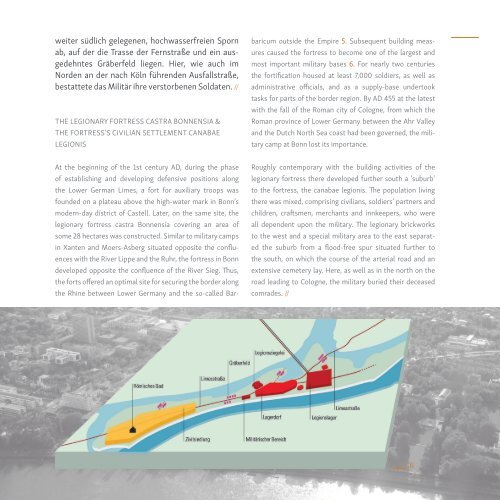Erfolgreiche ePaper selbst erstellen
Machen Sie aus Ihren PDF Publikationen ein blätterbares Flipbook mit unserer einzigartigen Google optimierten e-Paper Software.
weiter südlich gelegenen, hochwasserfreien Sporn<br />
ab, auf der die Trasse der Fernstraße und ein ausgedehntes<br />
Gräberfeld liegen. Hier, wie auch im<br />
Norden an der nach Köln führenden Ausfallstraße,<br />
bestattete das Militär ihre verstorbenen Soldaten. //<br />
THE LEGIONARY FORTRESS CASTRA BONNENSIA &<br />
THE FORTRESS’S CIVILIAN SETTLEMENT CANABAE<br />
LEGIONIS<br />
At the beginning of the 1st century AD, during the phase<br />
of establishing and developing defensive positions along<br />
the Lower German Limes, a fort for auxiliary troops was<br />
founded on a plateau above the high-water mark in Bonn’s<br />
modern-day district of Castell. Later, on the same site, the<br />
legionary fortress castra Bonnensia covering an area of<br />
some 28 hectares was constructed. Similar to military camps<br />
in Xanten and Moers-Asberg situated opposite the confluences<br />
with the River Lippe and the Ruhr, the fortress in Bonn<br />
developed opposite the confluence of the River Sieg. Thus,<br />
the forts offered an optimal site for securing the border along<br />
the Rhine between Lower Germany and the so-called Barbaricum<br />
outside the Empire 5. Subsequent building measures<br />
caused the fortress to become one of the largest and<br />
most important military bases 6. For nearly two centuries<br />
the fortification housed at least 7,000 soldiers, as well as<br />
administrative officials, and as a supply-base undertook<br />
tasks for parts of the border region. By AD 455 at the latest<br />
with the fall of the Roman city of Cologne, from which the<br />
Roman province of Lower Germany between the Ahr Valley<br />
and the Dutch North Sea coast had been governed, the military<br />
camp at Bonn lost its importance.<br />
Roughly contemporary with the building activities of the<br />
legionary fortress there developed further south a ‘suburb’<br />
to the fortress, the canabae legionis. The population living<br />
there was mixed, comprising civilians, soldiers’ partners and<br />
children, craftsmen, merchants and innkeepers, who were<br />
all dependent upon the military. The legionary brickworks<br />
to the west and a special military area to the east separated<br />
the suburb from a flood-free spur situated further to<br />
the south, on which the course of the arterial road and an<br />
extensive cemetery lay. Here, as well as in the north on the<br />
road leading to Cologne, the military buried their deceased<br />
comrades. //<br />
6




